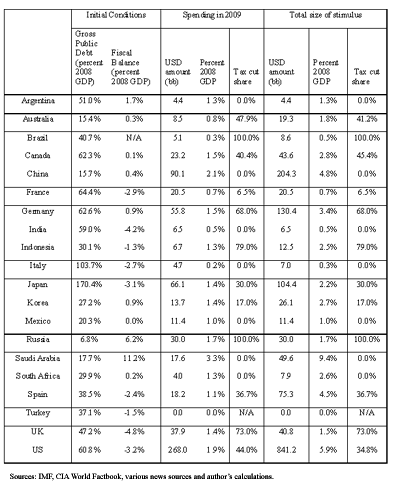Editor’s Note: Almost all of the G-20 countries have announced some type of fiscal stimulus plan to get their economies back on track but how strong are the plans and what measures are included? Eswar Prasad and Isaac Sorkin analyze the G-20 stimulus plans in detail in new research.
The financial crisis turned into a broader macroeconomic crisis in the fall of 2008. The world economy has hit a wall since then, with growth plunging in all the major advanced and emerging economies.
Monetary policy acted as a first line of defense against the crisis but conventional measures appear to have reached their limits in many countries. Policy interest rates in many countries–including the U.S., U.K. and Japan–are now close to the zero nominal interest rate floor. Moreover, the implosion of financial systems in many economies has rendered monetary transmission mechanisms far less effective.
Thus, fiscal policy has become essential to kick-start the global recovery or, at a minimum, to prevent global Gross Domestic Product (GDP) from declining further. At the November 2008 G-20 Summit in Washington, DC, the leaders of the G-20 countries promised to “use fiscal measures to stimulate domestic demand to rapid effect, as appropriate, while maintaining a policy framework conducive to fiscal sustainability.” How well have countries been doing on this promise?
In this note, we provide a detailed assessment of the stimulus measures in each of the G-20 economies. We first present data on the size of fiscal stimulus packages as announced by the authorities and compiled by the IMF.[1] These data represent estimates of the size of new measures, rather than the announced size of stimulus packages, which typically includes measures already planned before the scope of the crisis became clear. We then supplement these bottom-line numbers with additional information from a variety of sources. This allows us to evaluate the fiscal stimulus packages based on three key criteria:
- Size—the extent of stimulus relative to GDP
- Composition—balance between spending and revenue measures
- Frontloading—the speed with which fiscal measures hit the ground
These criteria enable us to systematically evaluate the potential punch packed by fiscal policy in each country. This analysis also sheds some light on the amount of stimulus on a global scale. In an integrated world economy, the effectiveness of stimulus is contingent on how coordinated it is across countries. If the sizes of the stimulus packages (relative to domestic GDP) are very different across countries or if the effects of some countries’ stimulus packages are backloaded, then there could be “leakage” of stimulus from countries that act early and forcefully.
Thus, lack of coordination could reduce the global bang for the buck of individual countries’ policies. Given the dire situation the world economy is in, large frontloaded stimulus packages that are coordinated internationally could not only be more effective directly but also boost consumer and corporate confidence.
Our analysis is limited to the G-20 countries, mainly because this has de facto become the main global grouping of countries that is driving responses to the crisis. The G-20 countries in this analysis (substituting Spain for the EU) constitute over three-quarters of global GDP (on a market exchange rate basis) and over two-thirds of the world’s population.
We begin with a broad assessment of the contours of stimulus packages announced so far. The interactive country map provides extensive details on individual countries’ packages. It also indicates our assessment of countries that have announced packages that are large and frontloaded (green), modest in size and speed (yellow) and unimpressive in both respects (grey).
Size of Stimulus
Almost all countries in the G-20 have announced fiscal stimulus measures.[2]
The total amount of stimulus in the G-20 amounts to about $692 billion for 2009, which is about 1.4 percent of their combined GDP and a little over 1.1 percent of global GDP. This is a significant amount of stimulus, but appears to fall short of what is needed to tackle a crisis of the proportion we are currently in. The IMF, for instance, has called for stimulus equal to 2 percent of global GDP.[3]
Three countries—the U.S., China and Japan—account for about $424 billion of the overall stimulus in 2009, with their shares in the overall global stimulus amounting to 39 percent (U.S.), 13 percent (China) and 10 percent (Japan). Measures for 2009 in the U.S. stimulus package amount to 1.9 percent of its 2008 GDP and the corresponding numbers for China and Japan are 2.1 percent and 1.4 percent, respectively. For the remaining G-20 economies, the total fiscal stimulus amounts to 1.0 percent of their overall GDP.
In 2010, the U.S. accounts for over 60 percent of planned stimulus. China and Germany are the next largest contributors with China contributing 15 percent of G-20 stimulus and Germany contributing 11 percent. Measures for 2010 in the U.S. stimulus package amount to 2.9 percent of 2008 GDP, China’s 2.3 percent, and Germany’s 2.0 percent.
In summary, while almost all countries have signed on to the fiscal stimulus program, the size of the stimulus varies substantially across countries, with some of the stimulus packages looking downright meek (e.g., France, which has proposed measures amounting to only 0.7 percent of GDP in 2009).
Composition of Stimulus
There is considerable discussion about the relative effectiveness of tax cuts versus spending in stimulating domestic demand. We do not take a position on this but it is useful nevertheless to examine the choices made by different countries in this dimension. We highlight one regularity in the composition of packages across countries and then indicate one dimension in which the structure of the packages differs markedly across countries.
Most countries that have announced multiple waves of stimulus have increased the share of spending (compared to tax cuts) in the second round, just as the U.S. has done from January 2008 to January 2009. For example, Germany’s stimulus in November 2008 was largely composed of tax cuts. The second stimulus package announced in January 2009 was largely tilted towards spending. Similar features can be found in the stimulus measures announced in Australia in October 2008 and February 2009, and in Spain in March 2008 in November 2008.
There is a great deal of variation across countries in the share of the stimulus that is devoted to tax cuts. In the U.S., this share is about 45 percent. Some countries—including Brazil, Russia and the U.K.—have focused almost entirely on tax cuts. Others—including Argentina, China and India—have mostly proposed spending measures. Among the G-20 countries excluding the U.S., about one-third of the stimulus is accounted for by tax cuts and the remainder by spending measures.
Speed of Stimulus
Countries vary in the degree of frontloading of their stimulus packages—the speed with which the tax and expenditure measures hit the real economy (in terms of money reaching the pockets of firms and households, or government monies being spent on social programs or procurement). This is partially a function of the vagaries of the budget process in each country—countries may not announce stimulus for the future though they intend to enact it as part of their regular budget process.
Of the 19 countries that make up the G-20, only four countries—China, Germany, Saudi Arabia, and the U.S.—plan to spend as much or more on stimulus (as a share of GDP) in 2010 than in 2009. In other words, there is a fair amount of frontloading in the stimulus packages of the G-20 countries, with much of the stimulus taking effect in 2009. Of course, this could reflect different beliefs about the length of the recession. It could also reflect difficulty in ramping up government expenditure quickly, especially on infrastructure and other investment projects.
We should also note that some countries recognized the coming crisis and implemented stimulus plans at some point in 2008. This list includes Australia, China, Japan, Korea, Saudi Arabia, South Africa, Spain, U.K. and the U.S.
Bottom Line
Fiscal stimulus has a crucial role to play in stabilizing the world economy, especially as conventional monetary policy appears to have reached its limit in many countries. By and large, policymakers in G-20 economies have acted on their leaders’ joint announcement in November 2008 to use fiscal stimulus in a concerted and coordinated manner to boost economic activity. Some countries like China and the U.S. have responded forcefully, with impressive packages. But the execution, both in terms of size and speed, leaves much to be desired in some of the G-20 countries.
There are legitimate questions about the effectiveness of fiscal stimulus, especially in economies where the financial system has broken down and where monetary policy can no longer play much of a supporting role. Moreover, excessive government borrowing to finance large budget deficits could itself generate instability and there are serious concerns about medium-term sustainability of fiscal positions in economies that are building up public debt at a rapid pace. Given the dire and fast-deteriorating economic situation and the lack of other tools, however, the world may have little choice but to engage in massive frontloaded fiscal expansion. The consequences of timidity, as history teaches us, could be even worse.
View larger version of the table »
View map resources »
[1] While we may have more up-to-date information for some countries, we have at this stage chosen not to selectively revise the IMF data to ensure consistency in the numbers. The new numbers do not affect any of our conclusions significantly.
[2] The G20 consists of 19 of the countries listed here except for Spain, with the 20th spot held by the European Union as a whole. However, at both the November 2008 meeting and the April 2009 meeting, Spain has a separate “seat at the table” because France and then the U.K. have given up the additional spot each of them would have had as head of the EU delegation for the respective meeting.
[3] http://www.imf.org/external/pubs/ft/survey/so/2008/INT122908A.htm




Commentary
Assessing the G-20 Stimulus Plans: A Deeper Look
March 5, 2009